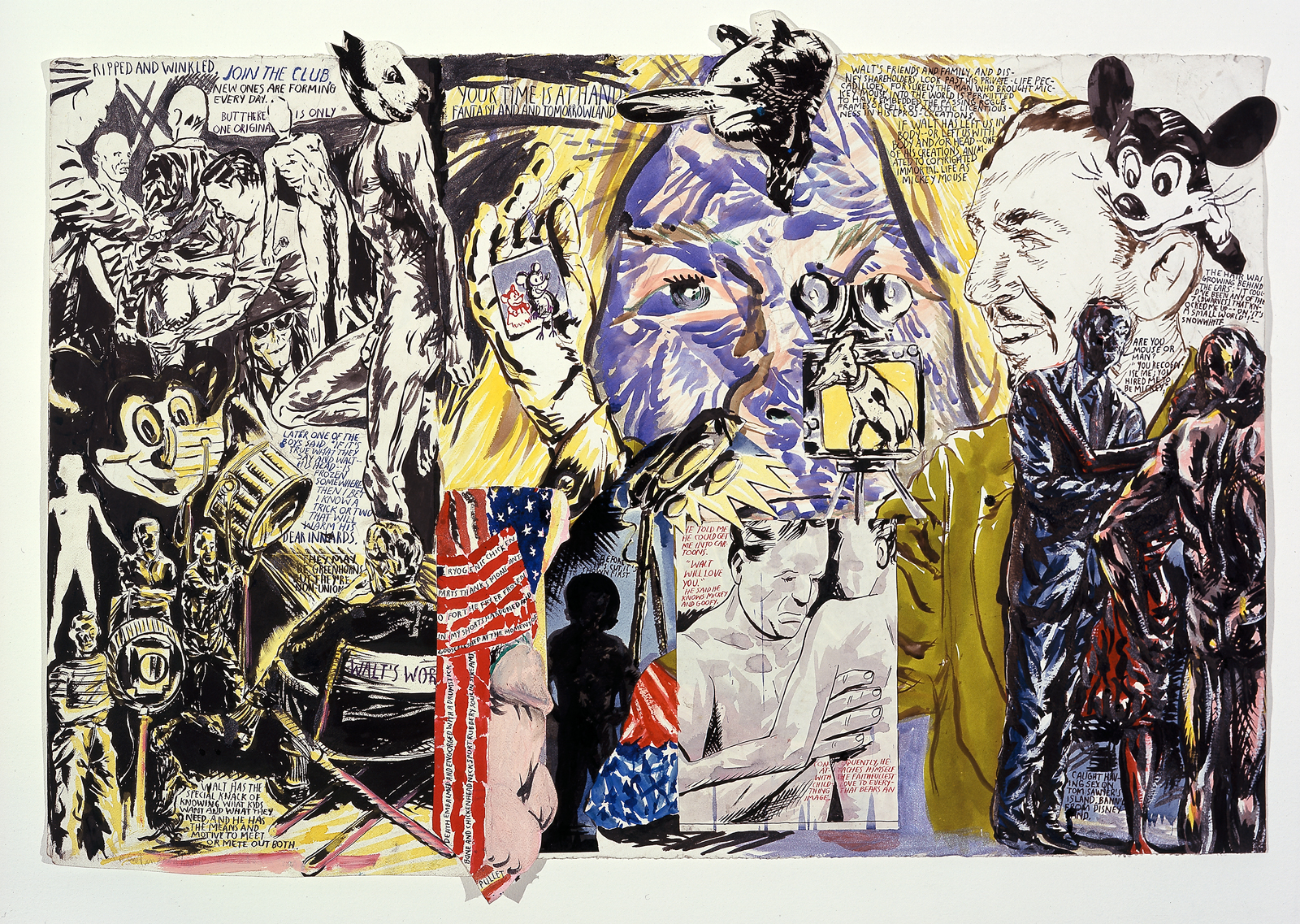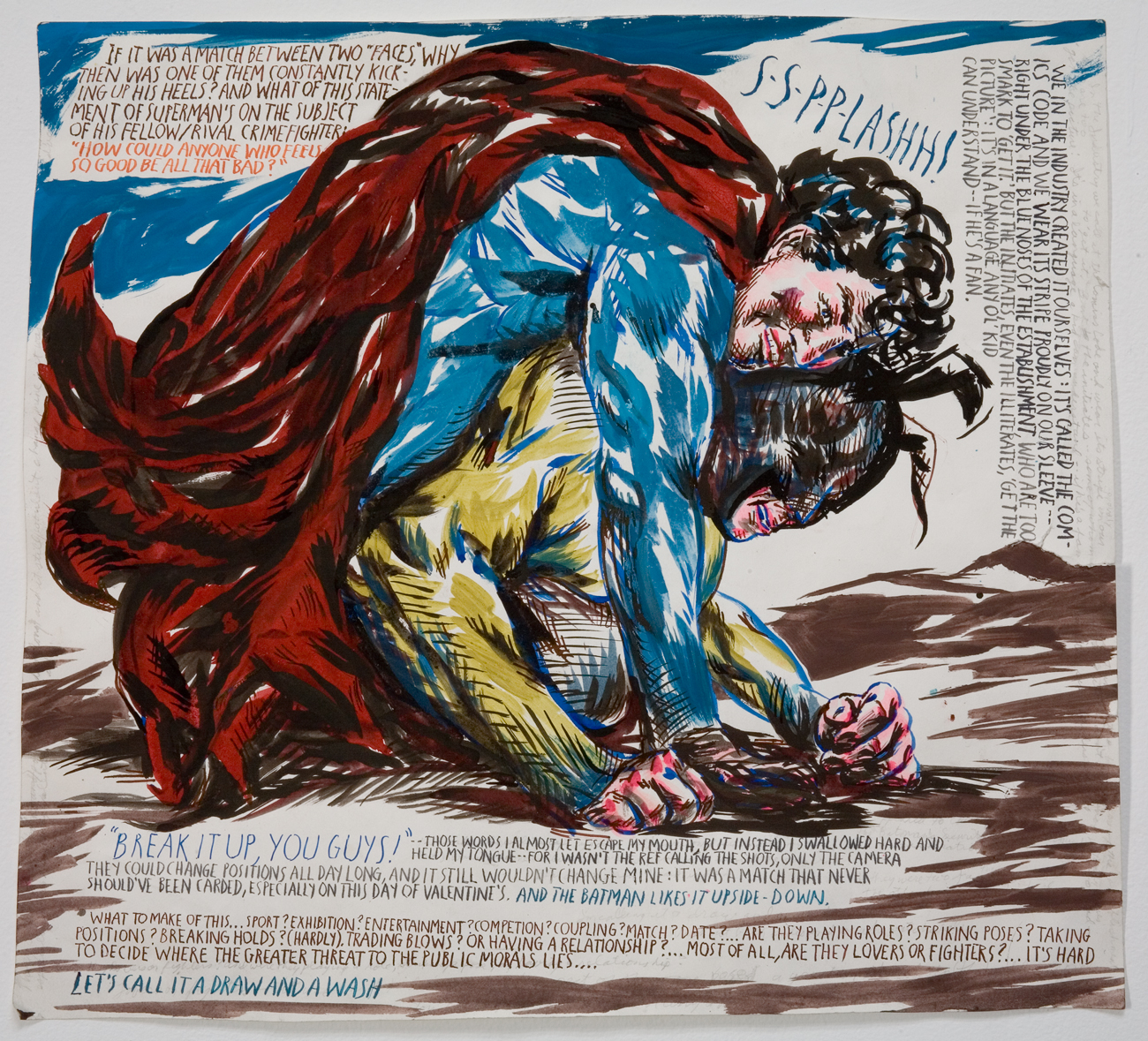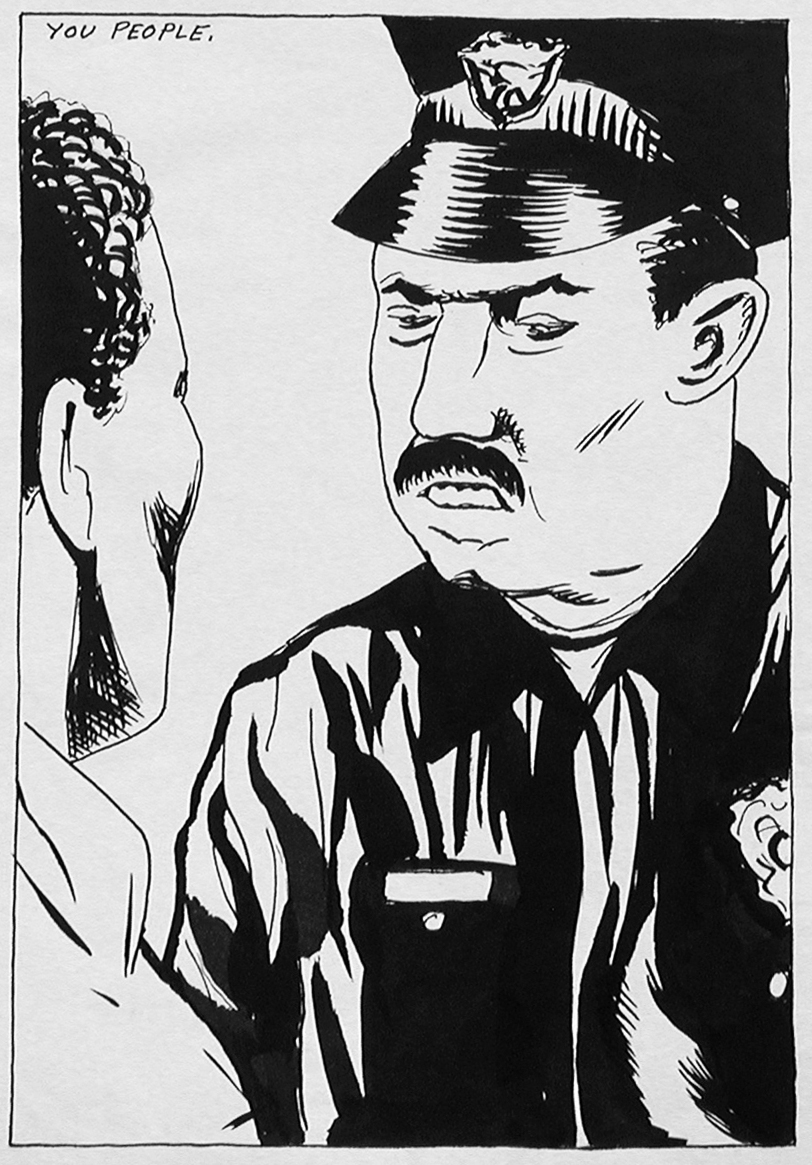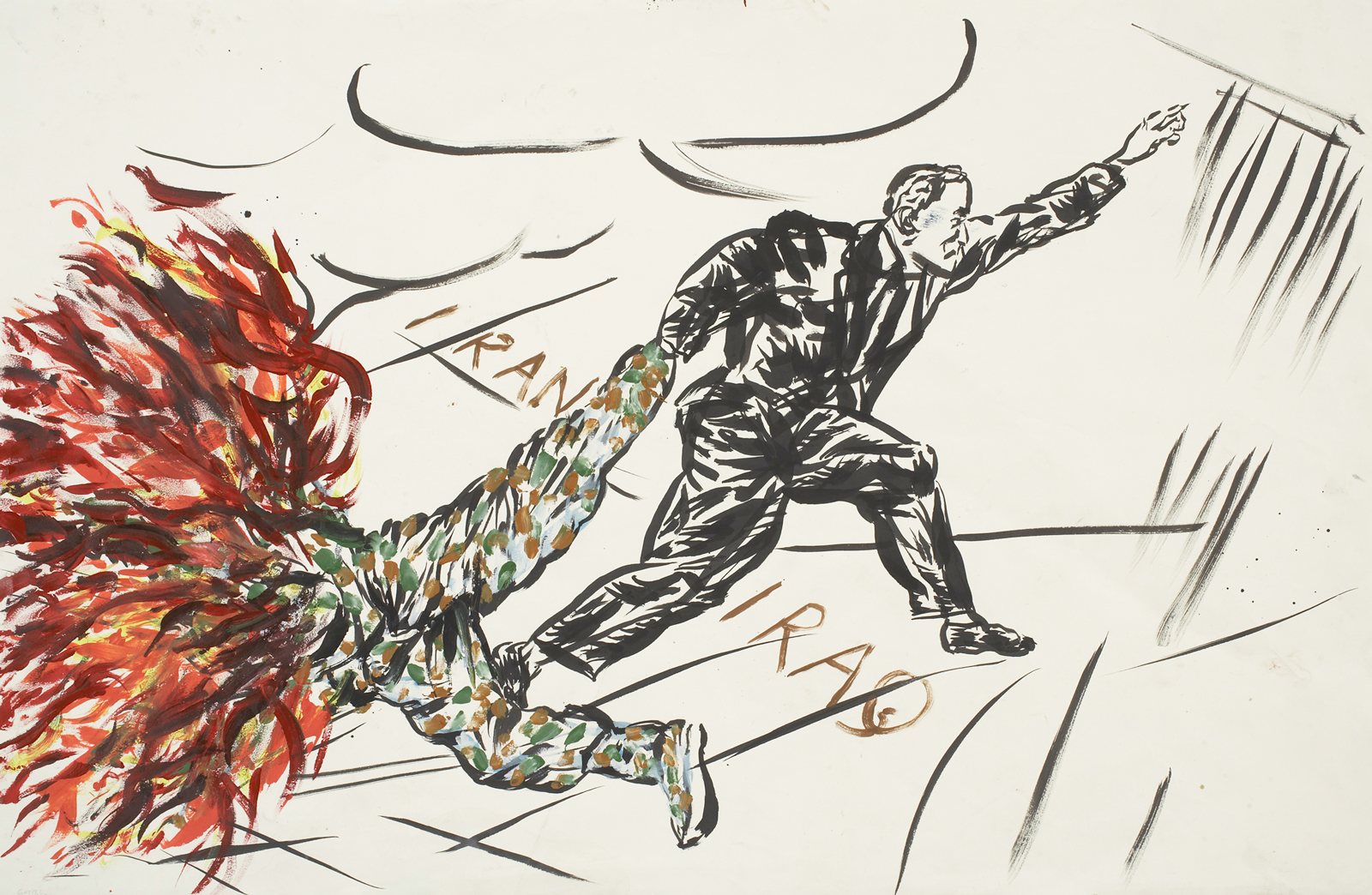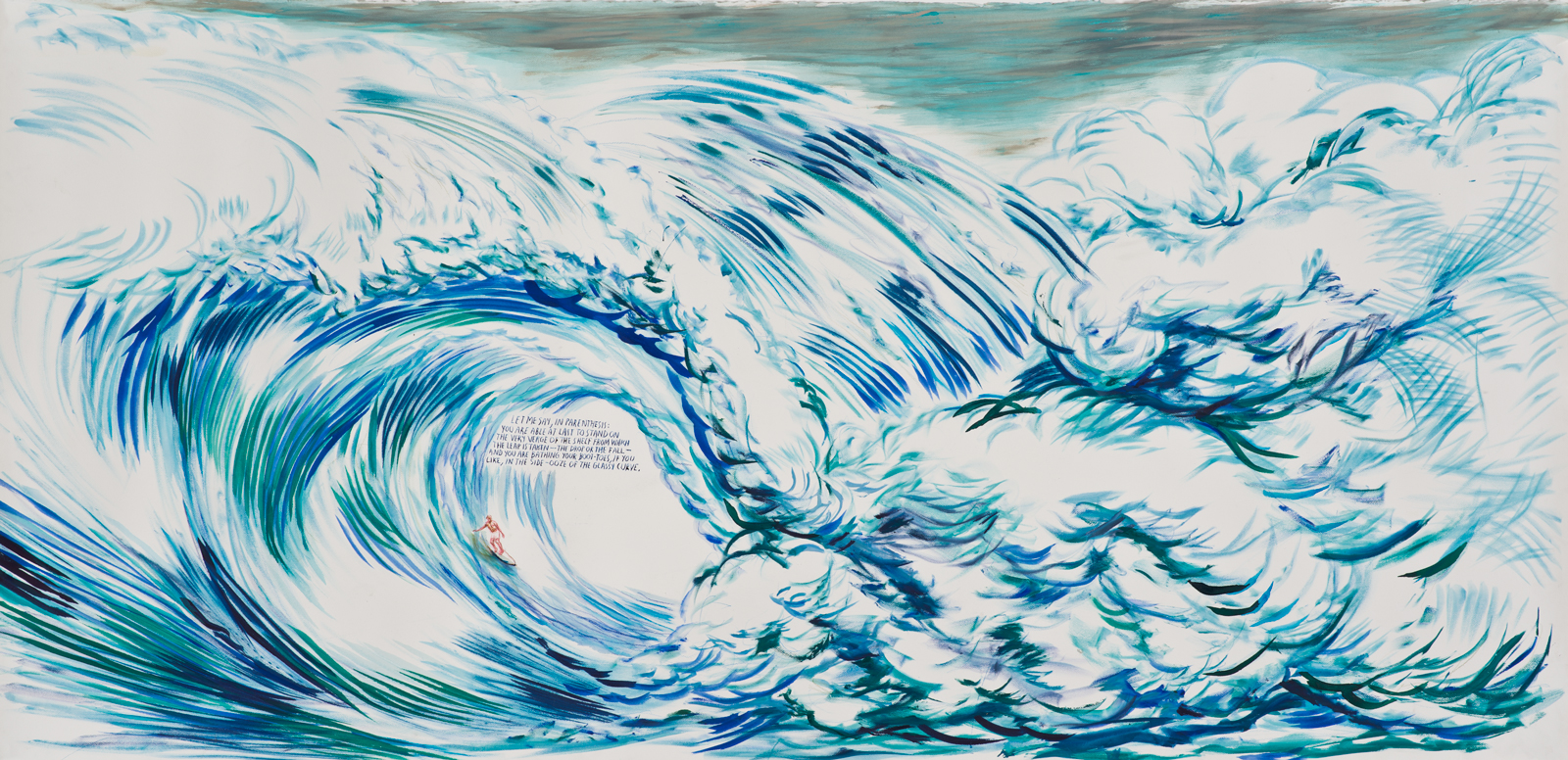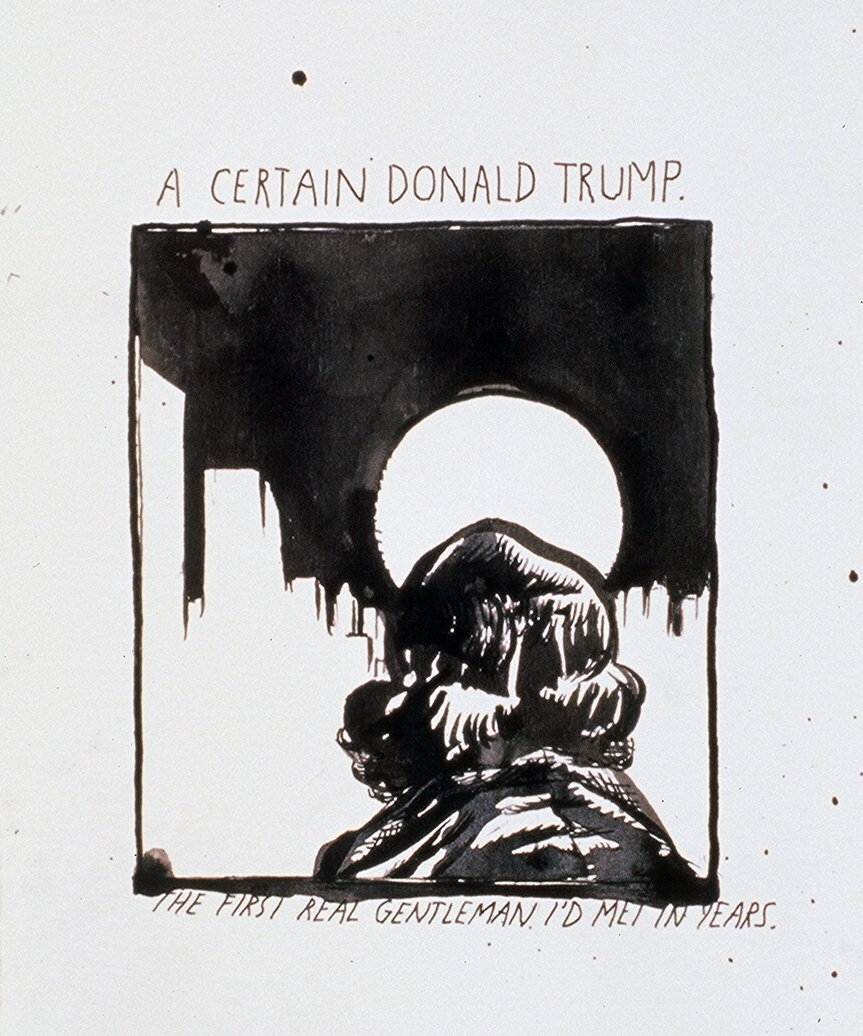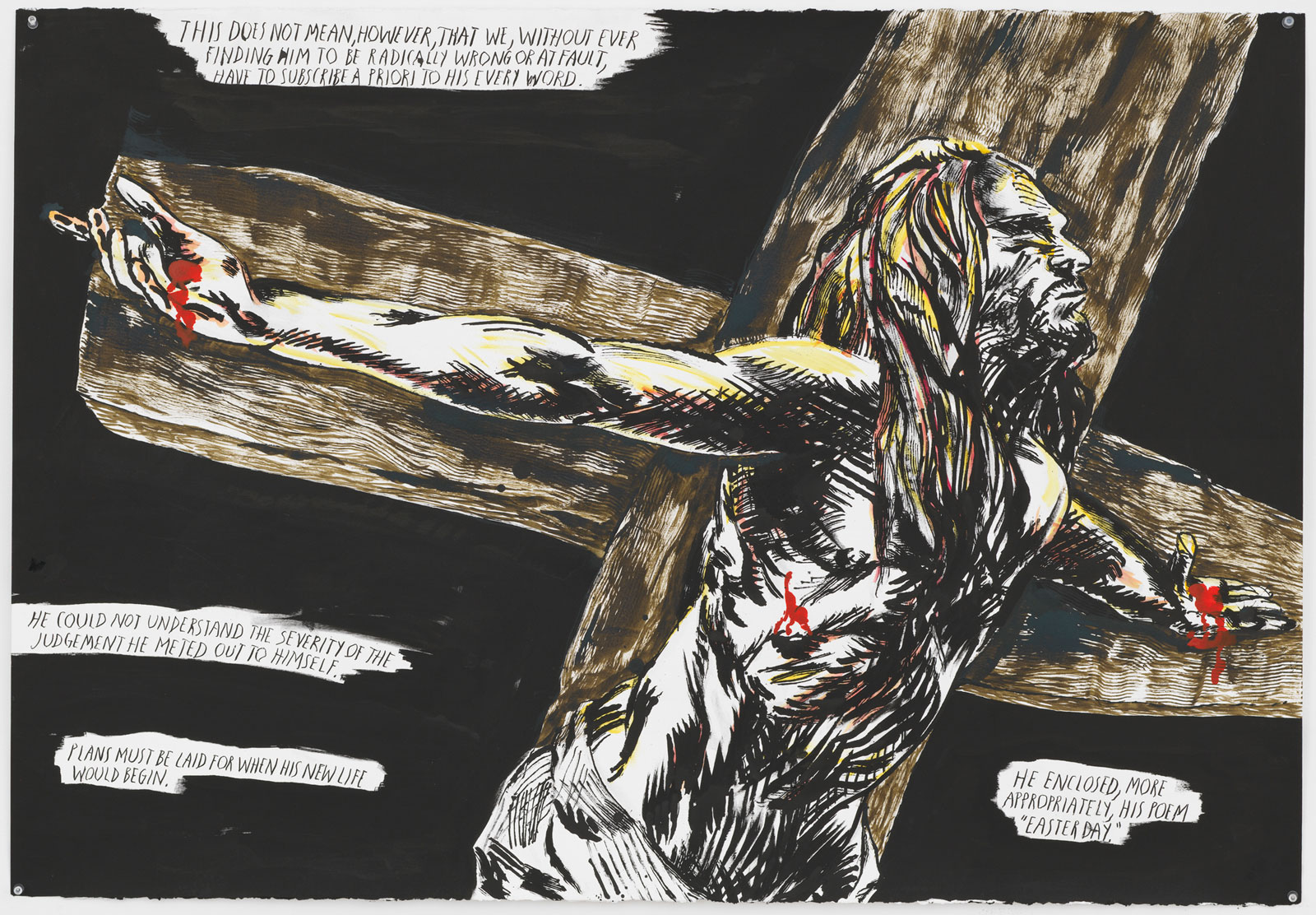If genius means anything anymore—for me it is the union of inexplicably keen insight with an uncanny capacity to say or show what others fail to articulate but everybody knows—then the artist Raymond Pettibon is one, the man of the hour at minutes to midnight on the Doomsday Clock. Fittingly, two exhibitions this spring, “TH’EXPLOSIYV SHOYRT T,” now at the David Zwirner Gallery, and “Raymond Pettibon: A Pen of All Work,” which recently closed at the New Museum, show an artist obsessed with the larger, grittier, and often hallucinatory contradictions of “this American life.”
Organized by the indefatigable curator and art-world networker Massimiliano Gioni, the New Museum show opened with a wall featuring a chronologically and stylistically synoptic array of drawings devoted to The Bomb; one, portraying a well-dressed woman looking at the blast, is laconically inscribed “Christina’s World.” Since 1945 bombs of all types and degrees of destructiveness—from Fat Boy to the Mother of All Bombs—have been emblems of modern life. A child of the “duck-and-cover” generation, Pettibon has thus lived with the threat of nuclear annihilation his entire life. The artist hasn’t gotten over the shock of learning that the world he had just entered might be over before he aged out of it.
Facing this cavalcade of mushroom clouds was a wall of queered super-hero drawings in which Superman and Batman reveal through combat and tough-guy repartee the degree to which they share the same ambiguously masculine DNA. The pair created an unnerving shock corridor of machismo, violence, and dread that opens out at either end on galleries crammed to overflowing with more of the same but with varying motifs. They were laid out in thematically subdivided clusters that similarly intermingle spare, awkward, early black-and-white sheets with colorful, overcharged, differently awkward late work on paper—sometimes accented by spasmodic pictorial eruptions and verbal ejaculations brushed directly onto the high white walls, as if the museum itself were an annex of Pettibon’s convoluted mental nodes. Call it Punk Muralism.
On the fourth floor these clusters ranged from suites of pages devoted to Nixon and Kennedy, to “W” and Cheney and their vicious “crusade” in the Middle East, to a drawing of Hitler embraced by a boy labeled “Our Pied Piper,” to a handful of notes on lynching and race war. One of these crudely depicts a snarling cop facing off against an African-American man. It is captioned “You people” and seems “torn from the headlines,” as sensational movie posters used to say.
So does another from the 1980s that pictures Stalin with the text “I should be President of the United States.” The inherent irony of their current resonance may seem prescient today but what they really demonstrate is how little the script of the cold war/law-and-order years has changed.
Gems of mordant humor and vivid imagery abounded. Given the blunt intensity of Pettibon’s style, the word “caricature” comes to mind; but at a recent dinner for Robert Crumb, where I was fortunate to be seated next to Pettibon, he was at pains to tell me that he is not a caricaturist, and when contrasted with the work of Crumb or of Paul McCarthy, Mike Kelley, Jim Shaw, and others of his California cohort he is right. He does not essentialize or exaggerate stereotypes as cartoonists do, he quotes them from disparate sources in a broad-stroke chiaroscuro manner that owes its punch to the old-school graphics on matchbook covers and the sensationalized naturalism of Ripley’s Believe It or Not illustrations. (Cases on the second floor of the exhibition showed a sampling of recent sources.)
But the literary Rosetta Stone of Pettibon’s groundbreaking works is the sheaves of mimeographed citations used by his father, who taught in community colleges and courses sponsored by the US Armed Forces. Pettibon combined these fragments of the Great Books with excerpts from pulp fiction such that the texts of his works echo with the optimistic cadences of Walt Whitman, the exaltation of Herman Melville, and the brooding mysteries of Edgar Allan Poe, juxtaposed with the tawdriness of Harold Robbins, Jacqueline Suzanne, and Mickey Spillane. Pettibon’s perfect impersonations of these and other writers make for a signal demonstration of post-modern collaging of the classics, while his emphasis on the Bible also points to the fact that the empowered, self-conscious reader—whom he frequently addresses directly—keeps the interpretation of those classics wide open.
Advertisement
Thus a version of the press photo of the hanging corpses of Mussolini and Clara Petacci reads, “We do not know the past. We read history as it is laid out chronologically, anesthetized on a table. What we know by ripples and spirals eddying out from us in our own time.” In Pettibon’s theory of history Lautréamont’s hallucinatory avant la lettre definition of Surrealism rings out even as he declares that “we” are the vessels through which history flows.
But this is just one of roughly six hundred sheets that were featured in the exhibition, many of which boast multiple annotated images. The flood of themes, icons, pictorial tropes, verbal asides, and dialectical mash-ups that spill out, and the sheer profusion of types and sizes of papers onto which they cascade—one room was wholly given over to meditations on surfing, several of them as big and tumultuous as Neo-Expressionist paintings—likely struck some viewers/readers as a surfeit of an already daunting art.
But who said art had to be easy on the eye or ear? And where a tighter, more discerning selection might have helped—connoisseurship of such freakishly hybrid work is not automatically in the skill set of all museum professionals—the ideal Pettibon retrospective would be equally cacophonous, just more excruciatingly memorable item-by-item.
That said, we can hope that there will be others in the future. If we have a future, and if the artist can continue to sublimate his demons and ours while enduring the punishment of having his eye on the chaos around and within him at all times. Only one image of our current president appeared in this show, as if its presence were an ellipsis. Will he become Pettibon’s next muse, his next incarnation of the banality of evil?
Given the crescendo of political anger in the New Museum, the current show at Zwirner is surprisingly devoid of any explicit references to a figure ready-made for Pettibon’s rage. Instead it focuses on the travails of a complex man haunted by private conflicts and quick to answer the voices in his head. Against a pitch black background two bands of text in the formal, third person diction he sometimes deploys appear on one wide sheet (forty-four inches across), effectively drawing parentheses around the existential crisis that seems to be in progress: “He could not understand the severity of the judgement [sic] he meted out to himself.… Plans must be laid for when his new life would begin.” With Philip Guston, Leon Golub, and Nancy Spero gone Pettibon may be our best hope for an unforgiving visual account of the disasters awaiting us.
“TH’EXPLOSIYV SHOYRT T” is at the David Zwirner Gallery through June 24. The catalog for the New Museum’s “Raymond Pettibon: A Pen of All Work” is published by the New Museum and Phaidon Press Limited.


